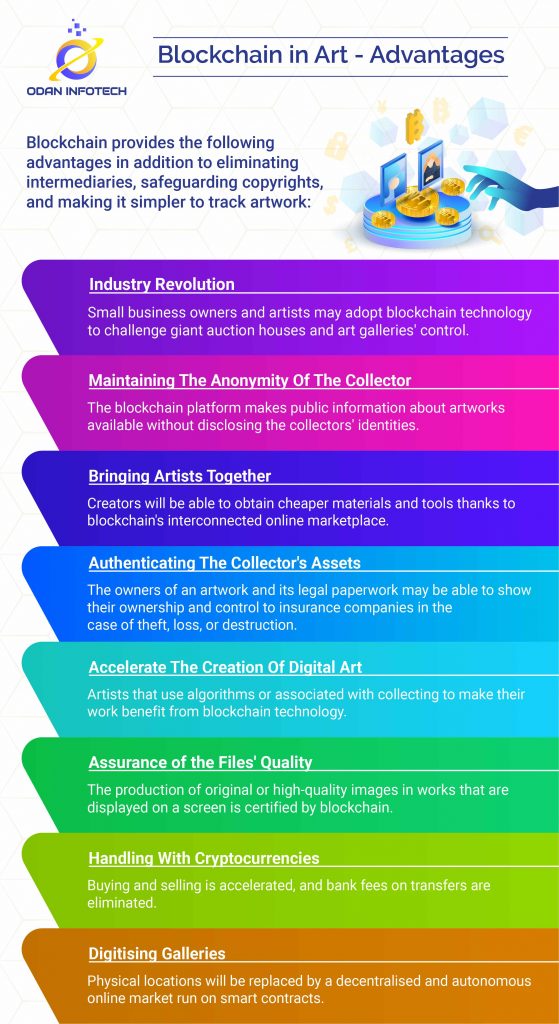Blockchain technology and the arts work together to come to realize human values and have the potential to transform the world, starting with the financial system and current creative sectors. Both have a strong impact and play a huge role in civic and cultural involvement.
Nowadays, blockchain project designers are inspired by the arts, and they are using blockchain technology to transform the creation, distribution, and perception of art. The major points of debate include the advantages of blockchain technology, which allows for immense degrees of transparency in the history of artwork as well as indisputable evidence of ownership. The goal of blockchain is to make art pieces more accessible while also transforming the arts industry's processes and approaches. Collectors, art galleries, and artists will see new prospects as a result of this.
For Example, Artists frequently complain that as performance-rights organizations and new intermediaries such as Spotify and YouTube increasingly enter the value chain between artists and their audiences, they are receiving a smaller cut of revenue and have less control over how their creative works are priced, shared, or advertised. Spotify it would take between 120 to 170 streams for rights holders to receive their first penny.
How Does Blockchain Play The Role In The Art Sector?
The financial sector is familiar with blockchain applications. They make it possible to conduct safe Internet transactions such as bitcoin payments and smart contracts. According to a survey conducted by industry analysts Wintergreen Research, this technology, which was developed in 2008, has a global market value of about 700 million dollars in 2017. It may reach $60 billion by 2024, according to their projections.
Its benefits are yet to be realized in other fields, such as art. But, in the not-too-distant future, blockchain applications in music, film, theatre, and publishing might lead to revolutionary advancements. The following are the key benefits:

The Use Of Mediators Is Being Decreased.
The increasing number of intermediaries in sales transactions makes it challenging for authors to reach their respective audiences and raises the cost of their work. The sale of artworks may earn some of the dealers on Forbes' list around one billion dollars each year. According to the Statista site, the worldwide art industry had 39 million transactions in 2017, resulting in a total value of 63 billion dollars.
Artists will regain ownership of their creations due to initiatives based on blockchain apps and smart contracts. They will be able to present and sell their art to potential purchasers in a safe and profitable online environment.
This technology is used by Maecenas Fine Art, a pioneer in blockchain-based art auctions. Sellers create an inventory of their works on this platform, and investors may buy them in chunks, minimizing the cost of the operation. There are no intermediaries, which is only feasible because of blockchain's transparency, traceability, and speed.
Guaranteed Protection For Intellectual Property
Copyright innovations can also benefit from blockchain technology. We can permanently save the intellectual property of work in the cloud and control it anywhere and whenever we want thanks to blockchain.
This increases transparency and protects copyright at a critical moment for Internet art: according to a Muso research on online piracy, there were 300 million visits to pirated material websites in 2017, up 1.6 percent from 2016.
Two firms, Kodak and Baidu, have blockchain efforts in place to secure and manage the intellectual property of pictures that circulate on the internet. To support the purchase of photographs on its site, Kodak employs a distinct cryptocurrency, whereas Baidu employs a blockchain-based program that stores copyright information.
Creative Content With Better Standardization
Blockchain may also be used to improve the traceability of artworks. We can follow the whole course of a painting, a sculpture, or any precious thing from its creation to its final destination since it is a complicated cryptographic technique.
Blockchain maintains data about an artwork's records, sales, research, analyses, certificates, appraisals, and so on. This lowers illegal cultural property trafficking and eliminates counterfeiting
The Open Music Initiative's Success
The transition of music to the Internet resulted in significant upheaval in the industry. We progressed from CD players to continuous audio (streaming) and the services that influence music content globally, such as Spotify (which had 191 million active users and over 40 million songs in September 2018 according to the company) and YouTube (which had over 5,000 million daily plays in June 2018 according to the data agency Omnicore.
Musicians demanded a solution that would allow them to own their works and get a more equitable share of the profits. Platforms like the Open Music Initiative, a non-profit organization that gives authors back control of their music, have developed among the various blockchain uses.
This program, led by Berklee College of Music and the Massachusetts Institute of Technology (MIT), is capable of measuring the number of times a piece of music is played, as well as where it is played. It can also create smart contracts that allow musicians to sell the rights to their own work in complete security and autonomy.
To prevent fraud and speculation, blockchain services have been developed in the ticket sales sector. Smart tickets allow event organizers to keep track of and prohibit resale tickets by creating unique registrations of authorized purchasers.
Conclusion
The artworld is quickly adopting blockchain technology. Blockchain technology continues to enable innovation in the industry, from innovative crypto art to asset tokenization and decentralized property rights registries.
Blockchain has the potential to disrupt barriers, resulting in enhanced efficiency, more accountability, fewer costs, and better recompense for artists. However, in order to reap these benefits, technology must be developed ethically and under appropriate legal frameworks.

